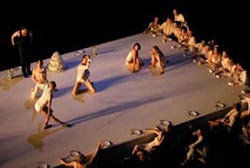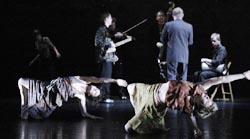“Displacement”, as the title suggests, is an exploration of the immigrant experience. A multimedia concert with choreography by Robert Glumbek, visual elements by Vessna Perunovich and a ravishing score by Christos Hatzis — immigrants to Canada, all — this recent presentation by the Hamilton Conservatory of the Arts Dance Theatre Company gilded the lily by featuring the acclaimed Penderecki String Quartet playing live. Where to begin dissecting such an embarrassment of artistic riches? Well, maybe don’t — because the whole here is definitely greater than the sum of the parts.
The opening image and sound is of a train, that most conventional symbol of journeys both hopeful and sinister. Projected onto the whole of the back wall, the filmed images punctuate and frame the movements of the six dancers onstage, happily without diminishing or competing with them. A wirework frame/sculpture of a house, again, the most readable of icons, is placed just in front of the projections and off to one side. A figure enters carrying a load of balloons on his back — and the dance begins.
Beginning with melancholy undertones of longing, the music and thus the dance become increasingly hectic and ominous. A dancer calls out the real names of cast mates — Brendan! (Wyatt), Rena! (Narumi), Anisa! (Tejpar), Tyler! (Gledhill), Ryan! (Lee) – and falls to the ground repeatedly. The strings of the ensemble swell. And on the projection screen, pretty blue skies with puffs of white morph into boiling storm clouds. Intensity builds and it never quite lets go for the duration of the piece. Fueled by furious strings, the company begins a section of tremendous agitation and energy, some carrying suitcases, some bound to each other by thick red bands of slightly stretchy fabric or rubber.
As a device, these bands became an irritant for me. What started out as a striking image and metaphor became diluted with three couples straining against these bouncy harnesses. Still, your mind can’t help but speculate. Are these blood ties or bonds of another kind keeping the tension between these couples lively? At times they can’t come together, at others they are torn apart or pulled back from the brink of escape. It’s a rich device, just one that’s used to excess. So it’s a bit unnerving when after some beautiful, more contained solo dancing by Tejpar and Bergfeldt, a couple returns to the stage with … white bands! By this point, most of the cast is trapped, standing as watching witnesses in the wire frame house, where they stay for a good long while.
The bands, the house, the suitcases – they suggest a narrative that is never fully realized but is perpetually hinted at and danced around in a way that is awkwardly rather than confidently impressionistic. At times the music seems to be driving the event — the dance is dancing as fast as it can just to keep up and, it feels on occasion, for no other reason. For me, that was unsettling, despite the brilliance of the score and its interpretation by the quartet. I find myself wondering if this lack of a narrative core, this neither/nor quality might be related to the fact that Glumbek’s opening night injury required significant re-casting and re-ordering of the sections of the work. Perhaps it slipped slightly out of balance during that (understandably challenging) process?
The final section is the most moving and fully realized. Perunovich has created a bell-like transparent sculpture that hangs suspended centre stage. It is described in the program notes as a “mother’s skirt”. Two people can just fit beneath it, Bergfeldt and another, embracing. One partner fades and someone takes his or her place. That partner in turn falls to the ground slipping out of Bergfeldt’s arms. She is now alone within this prison containment and she collapses exhausted on a suitcase that has been slipped over to her. At one point she awakens, takes a letter from the suitcase and begins reading it silently, then falls back to sleep. The piece ends with her cast mates pulling the sculpture down tightly over her resting form. There is a coherence in these closing moments that unites the different talents and disciplines on display to achieve an emotional legibility that anyone can relate to.
Whatever structural failings haunt this incarnation of “Displacement”, you certainly can’t fault the dancing. Glumbek’s choreographic style must be exciting to perform — sensuous, sinuous and with a ferocity that commands attention. The dancers spin, they fall and recover, they run — often flat out. With different, but equal, physical and technical gifts, the dancers rise to the occasion of Glumbek’s vision (and to the circumstances of this particular run as well), bringing tenderness, energy and commitment to a story of an all too common human experience.
Neither can you fault the playing — the Pendericki String Quartet’s interpretation of Hatzis’ rich score was quite simply exquisite. Would that all dance could be accompanied by such loving musical brilliance.
Tagged: Contemporary, Interdisciplinary, Performance, ON , Toronto





